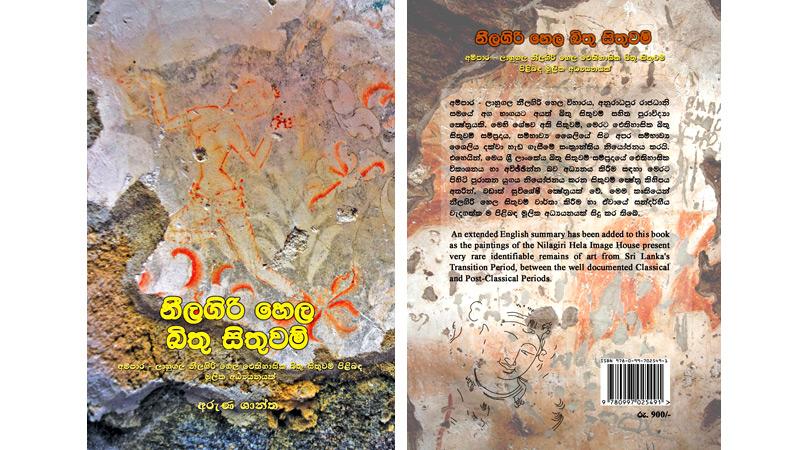
Aruna Shantha’s “Neelagiri Hela Bithusithuwam-Ampara-Lahugala Aithihasiaka Bithusithuwam Pilibanda Moolika Adhyayanayak” is his latest in a series of books in Sinhala on the ancient rock and wall paintings of Sri Lanka.
The title translates as “ Neelagiri Hela Wallpaintings - a preliminary study of the historic Ampara-Lahugala Neelagirihela wall-paintings”. With 102 pages, 30 photographs, nine illustrations, nine maps and four plans, the book is different from his previous books in that it includes a summary in English and is published by the author himself.
The wall paintings are found in an archaeological site named Neelagiri Hela in the Lahugala forest reserve in the Ampara district. Surrounded by dense forest, the site is difficult to reach. Due to passage of time, neglect and, recently, due to human activity, the paintings and the surroundings are showing signs of deterioration. Apart from the stated objective of documentation and study, the book is also intended to call attention to the fact that measures need to be put into effect without delay to prevent further decay and destruction.
The battle against terrorism had made archaeological sites in the North and the East inaccessible to archaeologists. Due to this reason, though the site had been discovered and the paintings documented decades ago, the paintings had not undergone a detailed study and many unique features had gone unnoticed. The book intends to remedy this situation and is dedicated to the Gunapala Senadheera, the archaeologist who did the preliminary studies and documentation in the 1960s. These paintings are rare and unique due to the period they belong to and the content and style of depiction. While paintings belonging to the medieval and modern periods are found at many sites, paintings belonging to the Anuradhapura period are quite rare. These paintings are dated as belonging to the 8-11 CE, the latter part of the Anuradhapura period, which is considered a transitory period. They provide a rare opportunity to gain insights into the development of the style that would come to be referred to as the Polonnaruwa Style.
They are found in an “image house”, an enclosure measuring 3.5 metres by 2.5 metres constructed under an outcropping of a rock (a cave complete with drip ledges) with an “asana”( a platform) to house an image of the Buddha. Paintings are on back as well as the sides. The depictions fall under three sections.
At the level of the “body” of the image is a landscape depicting a village with details such as plantain trees, “Tal” trees being tapped for toddy. At the level of the “Head” or “Sirsha”, a tree is depicted in a creative manner with celestial beings hovering around worshipping the Buddha. Above the depiction of the tree is sky rendered in a reddish tone. The style shows elements common to those found elsewhere as well as features not seen in other paintings.
Aruna Shantha’s series began with the publication in 2016 of “Kotiyagala Bithusithuwam-Kotiyagala Maillakanda Viharaye Bithusithuwam Pilibanda Adhyayanayak”( meaning “Kotiyagala Wallpaintings-A Study of the Wallpaintings of the Kotiyagala Maillakanda Temple”). Kotiyagala Maillakanda is an archaelogical site in the Moneragala district where, though documentation had been done decades earlier, there is no evidence of a methodical study. The book is intended to fill that gap. The site includes two “image houses”, one for a sculpture depicting the Buddha in a reclining posture and the other such in a seated posture. In both cases, the paintings form the backdrop and/or sides surrounding the images.
The image house with the reclining figure contains wall paintings from three distinct stages of the Anuradhapura Period. They are 6-8 CE, 9-10 BCE (mostly decorative motifs) and 9-11 CE. The second image house (i.e., sculpture in seated posture) has paintings from 8-11 CE. The depictions include the abodes of the Bodhisattva and the “Lokumbu Niraya”-which literally translates into English as “Metal Cauldron Hell”-a special “hell” constructed as a metal cauldron with fire beneath, inside which sinners are made to suffer. The book went into a second printing in 2017.
The next in the series is “Henannegala Bithusithuwam” published in 2018 following the successful reception to the previous book. This archaeological site at Maha Oya in the Ampara district, has a long cave- long outcropping of rock running along the length of the Henannegala Rock which have drip ledges cut into them.
These walls have paintings which have served as the backdrop and/or sides to images of the Buddha. These paintings date to the 8-13 CE, that is both the Anuradhapura and Polonnaruwa Periods. The depictions include halos to the main sculpture and Arahants. The book went into a second printing in 2019.
The third in the series published in 2020 is “Kurullangala Kurullo-Aithihasika ha Puravidya Lipi sangrahayak”. As its name indicates it is a collection of articles on history and archaeology and its name is derived from the title of one of the articles on a site in the Ravana Ella area of the Badulla district. It includes a study of prehistoric paintings and of stupas and stupa complexes and provides details that have gone unnoticed in preliminary studies.
Aruna Shatha’s books have focused on studying wall paintings and features of archaeological sites and structures dating from the prehistoric times and the Anuradhapura and the Polonnaruwa periods that as a whole have not received the attention they deserve due to many reasons such as inaccessibility. Apart from studies, the books draw attention to the rarity of the sites and archaeological evidence, the state of decay in which they are found today, and the need for action without delay to arrest further deterioration.
